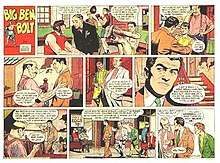Big Ben Bolt
Big Ben Bolt is a comic strip that was syndicated from February 20, 1950 to April 15, 1978.[1] It was drawn by John Cullen Murphy, written by Elliot Caplin, and distributed by King Features Syndicate. The strip followed the adventures of boxer and journalist Ben Bolt.[2][3]
| Big Ben Bolt | |
|---|---|
 John Cullen Murphy's Big Ben Bolt (July 26, 1978). | |
| Author(s) | Elliot Caplin |
| Illustrator(s) | John Cullen Murphy (1950-1977) Gray Morrow (1977–1978) |
| Current status/schedule | Concluded; Daily & Sunday |
| Launch date | February 20, 1950 |
| End date | April 15, 1978 |
| Syndicate(s) | King Features Syndicate |
| Genre(s) | Sports, adventure |
Publication history

In 1950, writer Elliot Caplin (brother of Li'l Abner cartoonist Al Capp) suggested that Murphy illustrate a boxing comic strip he had in mind. Comics historian Don Markstein wrote:
King Features Syndicate launched Ben's daily strip on February 20, 1950, and the Sunday version on May 25, 1952. The character's name was probably taken from Thomas Dunn English's poem, "Ben Bolt", which has remained popular since it first appeared in 1843.[4]
Murphy was the artist of Big Ben Bolt from 1950 to 1978.[5] He occasionally used assistants, including Al Williamson (Flash Gordon), Alex Kotzky (Apartment 3-G), Neal Adams (Deadman), John Celardo (Tarzan) and Stan Drake (The Heart of Juliet Jones). In 1971, Murphy took over Prince Valiant, and Gray Morrow stepped in to draw Big Ben Bolt, eventually signing the strip starting August 1, 1977. Big Ben Bolt ended on April 15, 1978.[1]
King Features' email service, DailyINK, began carrying Big Ben Bolt in June 2010.[6]
Characters and story
As Markstein writes,
Ben himself ran against stereotype. Instead of a big, dumb hitting machine, he was an articulate college graduate who had chosen a boxing career because he enjoyed and was good at it (winning the world heavyweight championship early on), not because other fields weren't open to him. In fact, when, in 1955, an injury took him out of the ring, he went into journalism. For decades, his adventures revolved around writing about, rather than practicing, his chosen sport.[4]
Awards
Murphy received the National Cartoonists Society's Award for Story Comic Strip for 1971 for his work on Big Ben Bolt and Prince Valiant.[7]
References
- Holtz, Allan (2012). American Newspaper Comics: An Encyclopedic Reference Guide. Ann Arbor: The University of Michigan Press. p. 72. ISBN 9780472117567.
- "FFF - Fumetto, Big Ben Bolt". www.lfb.it (in Italian). Retrieved 2018-10-10.
- Guida Fumetto Italiano. "Guida Fumetto Italiano". www.guidafumettoitaliano.com. Retrieved 2018-10-10.
- Big Ben Bolt at Don Markstein's Toonopedia. Archived from the original on August 27, 2015.
- The Archivist (February 12, 2015). "Ask the Archivist: BIG BEN BOLT". Comics Kingdom.
- Koenigsberg, Moses (1941). King News: An Autobiography. F.A. Stokes Company. p. 511. ISBN 0836999177.
- "Newspaper Strips — See Winners → Story". National Cartoonists Society. Retrieved October 10, 2018.
Further reading
- Strickler, Dave. Syndicated Comic Strips and Artists, 1924-1995: The Complete Index. Cambria, California: Comics Access, 1995. ISBN 0-9700077-0-1